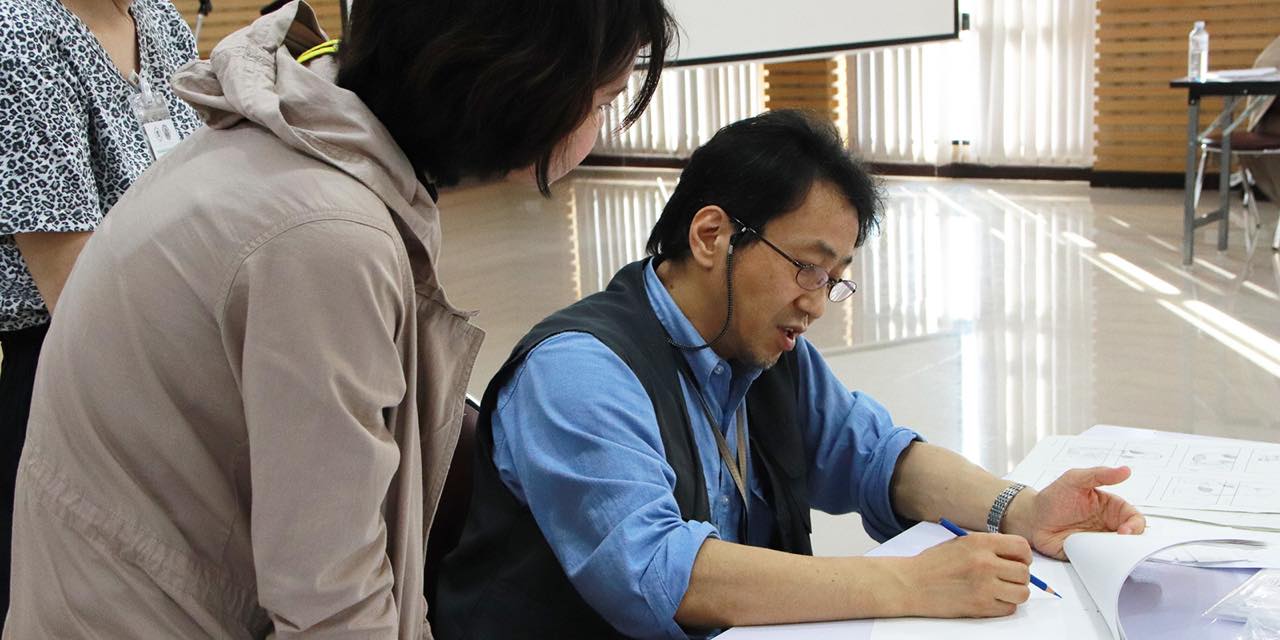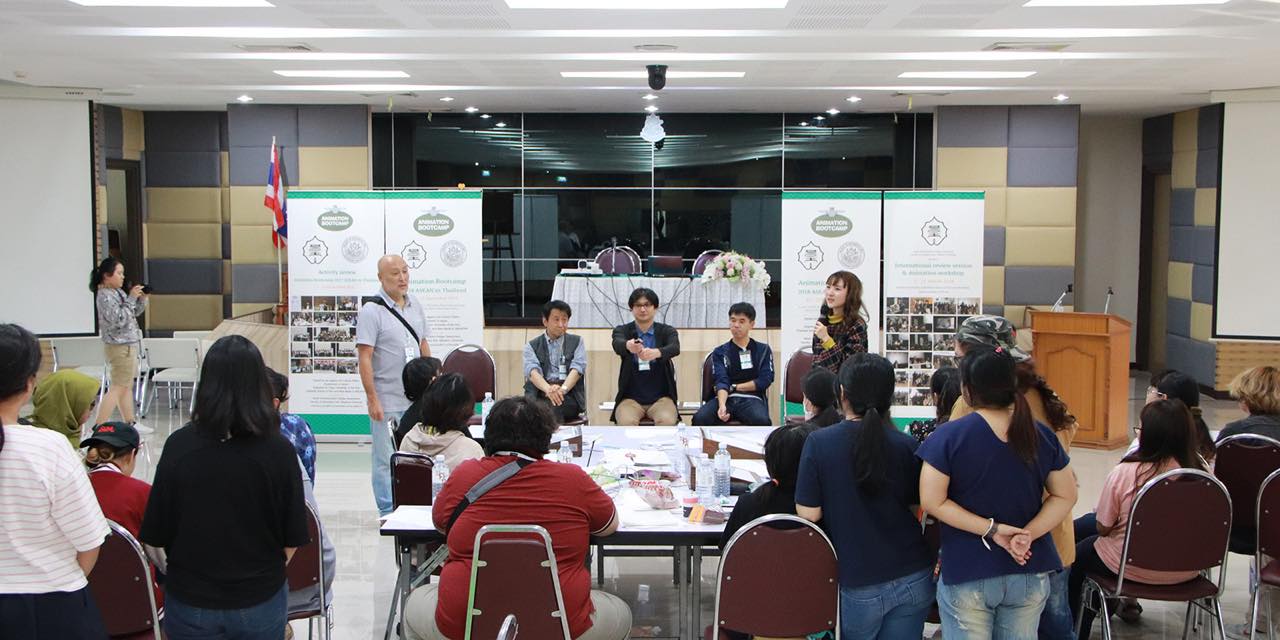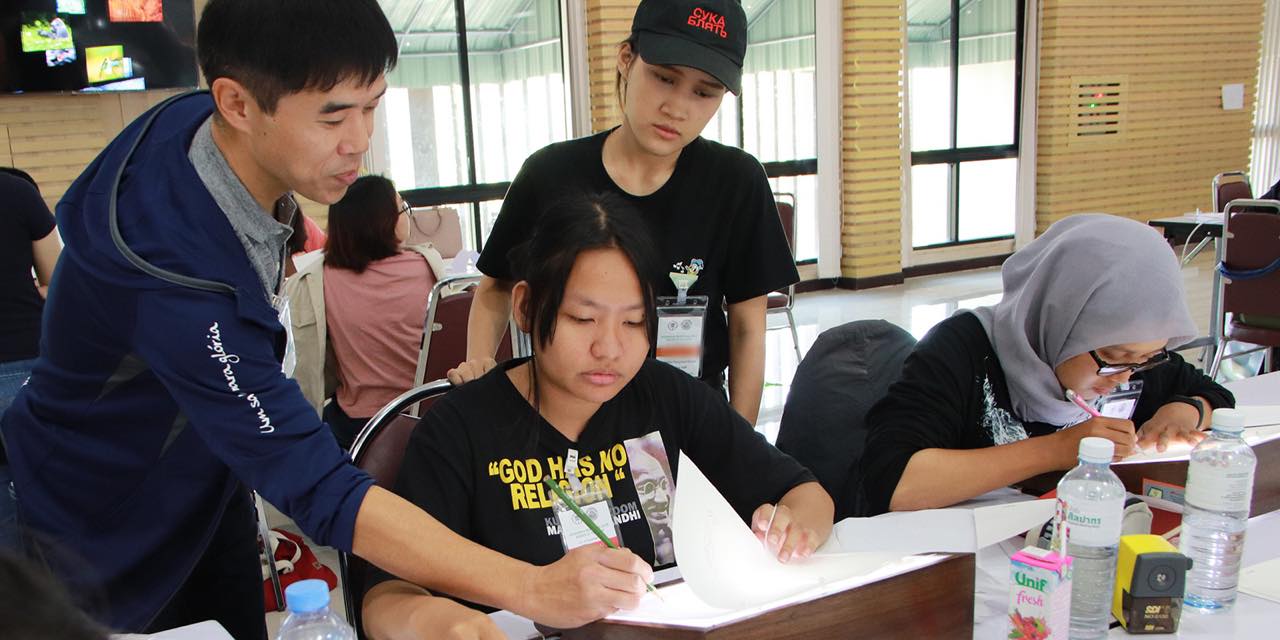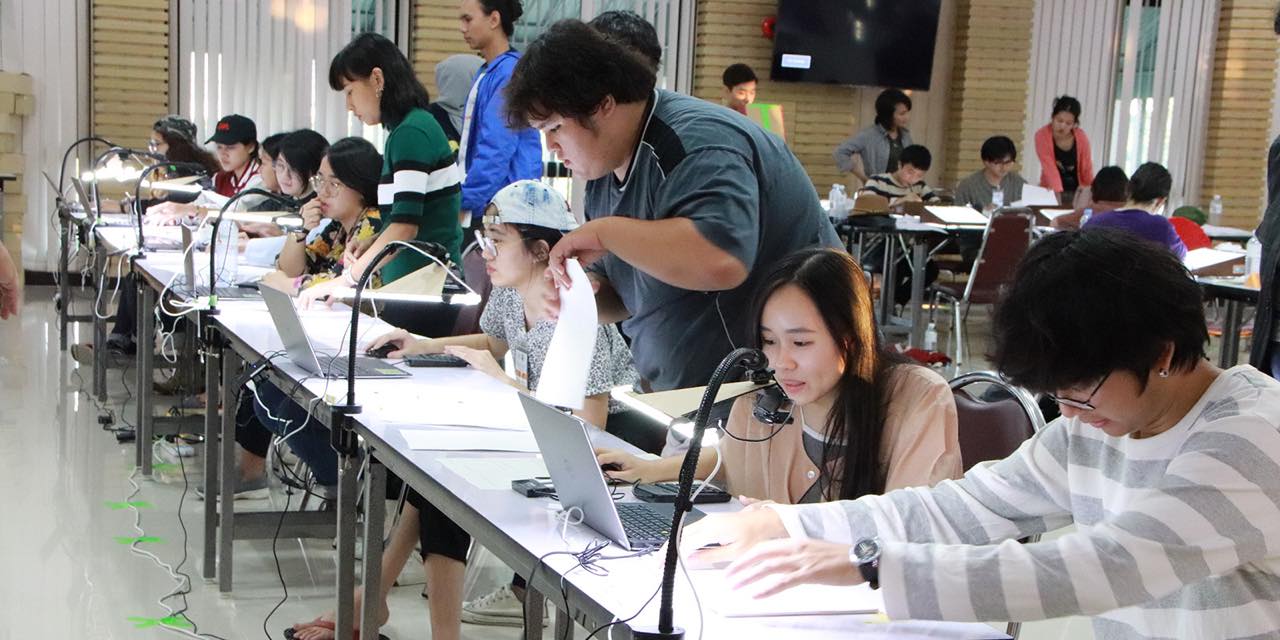Background and Objectives
Thailand is one of the ASEAN countries where Japanese animation is most well-received. Research conducted in 2018 found that Thailand had the 12th highest number of overseas contracts (television, film, videogram, streaming, merchandising, etc.) with Japanese animation companies and far surpassed other ASEAN countries (5th in Asia behind Korea, Taiwan, China and Hong Kong). *1
Also, looking at their history, Japan and Thailand have had a deep relationship in the animation realm. Kantana Animation Studios of the Kantana Group, which is Thailand’s largest and oldest production studio, started out as a subcontracting company for Japan’s Toei Animation. Thailand’s animation industry is still in the development stage, but the younger generation is behind the new wave in animation production seen in the establishment of numerous new animation production studios beyond Kantana and the 2018 release of the 3DCG animation film The Legend of Muay Thai: 9 Satra.*2 These emerging young creators and students have learned much from overseas animation, and they are particularly influenced by Japanese animation works. However, until now they had few opportunities to receive direct instruction from Japanese animators. In response to this situation, we started a hands-on workshop where we dispatched three prominent professional animators from Japan to teach the basics of animation expression to local young talents in Thailand. The curriculum and teaching methods were based on the Animation Boot Camp workshops, which have been held since fiscal 2012 by the Agency for Culture Affairs as one of their media arts projects.*3
Animation Boot Camp is an educational program that aims to “train talent who can seek personal growth and development.” It teaches the basics and essentials of animation and emphasizes the importance of “observing” and “feeling” through one’s own body and the pursuit of “expression that communicates to others.” Instructors were comprised of Japan’s top animators who are rarely able to make public appearances and the workshop allowed students to receive direct guidance from then. By conducting the workshop in Thailand, we aimed to inspire local young talents and give them an indepth understanding of Japanese animation.
The workshop in Thailand was first held as part of this project in 2015, and the content of the
workshop has been acclaimed each year by participating students and faculty at local universities.
Furthermore, the workshop has produced tangible outcomes including several works produced by workshop alumni winning awards at film festivals within Thailand and abroad. Also, Tokyo University of the Arts students have participated in the workshop since 2016, and interaction among the Thai and Japanese students has become an integral aspect of this workshop. For this iteration of the workshop, Indonesian students joined for the first time, resulting in a collaborative workshop among the three countries of Thailand, Indonesia and Japan.*4
*1: The Association of Japanese Animations. (2018). Anime Industry Report 2018.
*2: Prodused by Igloo Studio, which we visited in 2017 as part of this project.
*3: The following website has details on Animation Boot Camp.
http://animationbootcam.info/
*4: The Tokyo University of Arts students included two exchange students from China and one exchange student from Korea, resulting in students from five countries in total.
Team
The Japanese operations were led by co-directors Koji Takeuchi and Taruto Fuyama with the team that has executed Boot Camp in Japan over the past six years since 2012 as the core staff, and the instructors were animators with Boot Camp experience in Japan. In addition, smooth operations in Thailand were ensured by having coordination with the university handled by Tokyo University of the Arts, which has deep ties with Thai host institution Silpakorn University, and overall management by UNIJAPAN. Also, the interpretation was handled by the professional translator who has been continually involved in this project since 2016.
Instructor Profiles
-
Yoshimi Itazu (Animator, Director)
-
Toru Okubo (Character Designer, Animation Director/ Production I.G, Inc.)
-
Shinji Seya (Animation Director / Tezuka Productions Co., Ltd., Animation Direction)
Project Overview
《Project Name》
Animation Boot Camp 2018 ASEAN
《Date》
December 20 (Thur.) to 23 (Sun.), 2018
《Venue》
Silpakorn University, Sanam Chandra Palace Campus (located in Nakhon Pathom Province, about 50 kilometers to the west of Bangkok)
《Participants》
31 students
- 21 Thai students
- 4 Indonesian students
- 6 graduate students from Tokyo University of the Arts*2
《Students’ University Affiliation》
Silpakorn University
- Visual Communication Design Department, Faculty of Decorative Arts (17 students)
- Interior Design Department, Faculty of Decorative Arts (2)
- Applied Arts Department, Faculty of Decorative Arts (2)
Indonesian Institute of the Arts, Yogyakarta (ISI Yogyakarta)
- Visual Communication Design (4)
Tokyo University of the Arts
- Graduate School of Film and New Media, Department of Animation (6)*3
Details of the Workshop
《Pre-orientation》
On the day before the workshop, the participants already had the opportunity to meet each other so we hastily decided to hold a simple workshop, which served as an orientation to convey the philosophy of Boot Camp to the participants.
Director Takeuchi started out by leading everyone in light stretching and conducted an exercise that had the participants walk around the room. For the exercise, participants had to walk to the tempo set by a metronome. The tempo gradually increased from 120 to 180 bps, and by the end everyone was trotting. They finished the “walking” out of breath. Then, Director Takeuchi gave them the following explanation:
There are various speeds to “walking,” but two steps per second is the basic “internal clock” tempo for humans. Three steps per second is “trotting,” and four steps turns into “running.” Even the world’s fastest runner Usain Bolt can’t run six steps per second. At Boot Camp, we learn about this common denominator known as the human body. It exists not within your mind, but within all of your bodies. Expression that takes commonalities into consideration also communicates to other people. And, “expression” becomes real for the first time when it gets across to other people. Boot Camp is about learning that.
After the explanation, each participant made a paper doll for use as a tool to assist with the animation. This paper doll can take on various poses, and it is a teaching tool unique to Boot Camp that was devised for participants who aren’t good at drawing characters.
After this round of activities, the instructors, teaching assistants and Indonesian teachers were
introduced and the orientation came to a close.
《Day 1》
1) “Jumping” assignment
For this Boot Camp, the participants did three assignments that were structured into stages. It would
have been difficult for the students to suddenly tackle the open-ended main assignment, since the participants included students drawing animation for the first time. So, two stages of “jumping” and “walking” served as basic training to teach them this basic workflow: “Animate after finding the key poses based on observation. The “jumping” assignment came first.
〈Draw jumping〉
- Draw one of the following two jumps.
- A) A boy grabs a balloon caught on a tree branch (jumping in place).
- B) A boy jumps over a puddle (jumping forward).
- First, observe the actual movements of jumping by checking your own actions when you
jump and observing the movements of your group members.
- Based on the observed behavior, use the designated “thumbnail” method to draw as many of the poses in the jumping movement as possible.
First, each group talked among themselves to pick one of the two scenarios. This resulted in all of the groups picking the A) scenario. Next, they used their own bodies to observe the specific jump and the poses that are in the movement. They drew lots of poses, following the designated “thumbnail” method. This method was newly devised for this Boot Camp workshop and has participants draw as many small pictures of poses as possible. The specific procedure is to first draw the start pose and end pose for the movement at the top of the page. Next, draw the pose that is in between. Then, draw as many of the poses in between as possible at the bottom of the paper. This way, participants find the poses in order of importance within the overall movement, and they do it in stages so that even beginners can understand.
After about an hour of work, they pasted the completed thumbnail drawings on the wall and
attached sticky notes to the poses that they thought were suitable. After they all looked at the poses tagged with sticky notes, Mr. Seya reviewed their work and gave a lecture. In the lecture, he used specific examples to explain that observation is important for drawing suitable poses, and that there are new discoveries to be made through observation.
After the thumbnails, they used animation paper to draw the jumping motion once again. Then, they photographed the drawings using the Koma Koma animation playback software developed by Director Fuyama, and then all of their jump animations were screened group by group.
2) “Walking” assignment
“Walking” was the next assignment. The basic workflow was the same as the jumping assignment. Participants first moved their bodies and did observations of walking, and then they drew thumbnails and found key poses. Before doing their drawings on actual animation paper, Mr. Seya gave a lecture on “walking,” and he used real examples to explain points to keep in mind. After the lecture, each group drew two steps of walking on animation paper and photographed the drawings with the Koma Koma software, just like the jumping assignment, and all their work was screened. Then, they broke up into groups and the instructors reviewed their work. Through the above “jumping” and “walking” assignments, all participants understood the approach of “discovering key poses through observation and using those poses as the basis for animation.” Next, they embarked on the main assignment.
3) “Box” assignment
The “box” assignment was the main assignment. Each group thought up a story based on the following premise: “The protagonist is moving a box with something like a watermelon inside, and the contents spill out when he or she falls. The contents are unexpected so he or she returns it to the box and walks off.” Then, each group expressed the story in five scenes, with each person in charge of one scene. This assignment has basically been used continuously during the past three years, but this year we made it more open-ended by making the contents of the box “something like a watermelon” instead of a “watermelon.”
The “jumping” and “walking” assignments were completed individually, but communication within each team was essential for the “box” assignment. First, each team had discussions to decide their story. They checked the story with the instructors, and after getting approval they drew their storyboards. Their goal for the day was to complete a storyboard movie showing the overall story through photographing the storyboard drawings with the Koma Checker software developed by Director Fuyama. However, Day 1 had one more assignment than previous years and we ran out of time, and the storyboard photography was postponed to Day 2.
《Day 2》
The morning of Day 2 was used to continue the storyboard production left over from Day 1. An overall screening was held around 11:00, when all of the teams completed their storyboards. After that, each participant aimed initially to draw all of the key poses for the scene that he or she was in charge of.
Actual watermelons and boxes were placed in the venue while the students were drawing. They picked them up over and over to use their own bodies to figure out the body movements as they drew.
The three instructors responded to questions from the students with actual drawings and gave advice on test footage photographed with the Koma Checker software. The instructors’ feedback and advice were interpreted to either Thai or English.
Works-in-progress were screened around 15:00. Then, Mr. Seya explained “in-between” work,
which is doing the drawings between the key poses, and the participants proceeded with the goal of completing as many drawings as possible. The second screening was held at 18:00, bringing Day 2 to a close.
《Day 3》
Participants started off the morning of the final day by writing down their goals for clarification. After that, the morning was designated for finishing the assignment. By 13:00, all of the teams had successfully completed their work.
After lunch, there was a screening of the Production I.G film Pigtails, which Mr. Itazu worked on as an animator. Before the screening, Mr. Itazu gave a brief overview of the film, namely that the film is an adaptation of a manga by Kyo Machiko and was produced in response to the Great East Japan Earthquake. He also made Pigtails storyboards and model sheets available for participants to look at after the screening.
After the Pigtails screening, the finished assignments were screened and reviewed. Director Takeuchi asked each participant to vocalize real-time sound effects when his or her section was screened. The students seemed reluctant at first, but everyone did a great job once things got going and the screening concluded with enthusiastic applause. It seemed clear that each and every student was able to genuinely experience the joy of seeing his or her ideas get across to the audience. After the screening, the instructors critiqued each team’s work and summarized the strengths and aspects that still needed work. There was a question and answer session after the review. The instructors responded with enthusiasm to each and every question, which were mainly related to animation production in Japan, including, “What kind of software is used for Japanese animation production?” “What is the process for producing Japanese animation?” “Different animators work on each scene, so how are they all able to draw the same characters?” and “Are there differences in producing anime based on a manga compared with original stories?” Also, there were questions from students who appeared to have hopes of working in Japan in the future, such as “Do Japanese anime studios accept interns from overseas?”
After the Q&A session, each student received a Certificate of Completion and the entire program came to an end. The atmosphere of camaraderie continued even after the closing ceremony, with Japanese students and Thai students exchanging contact information and some students asking the instructors for autographs.
Questionnaire Responses from Workshop Participants
- Was this workshop interesting?
It was very interesting. 13
It was interesting to a certain degree. 7
- Were you able to understand the content of this workshop well?
I was able to understand fully. 17
I was able to understand to a certain degree. 3
- Was the curriculum appropriate?
It was very appropriate. 12
It was appropriate to a certain degree. 8
- Were the instructions given in the workshop appropriate?
It was very appropriate. 15
It was appropriate to a certain degree. 5
- Do you think that what you learned in this workshop will be useful in your future projects?
It will be very useful. 16
It will be useful to a certain degree. 2
Not sure 2
- Please list some of the things you have learned in this workshop.
- Correct “human walking”
- Method for smoothly drawing movement and how to draw
facial expressions
- About the details within movement
- Method for more naturally drawing movement by doing correct drawings for each frame
- Skill improvement
- How to tackle the project as a team. Even though this point is important, it has not been given this much attention at school or other workshops.
- Time management, how to do animation timing, how to
make animation smooth
- How to create smoother animation. The instructors gave me detailed advice.
- About dynamic movement, natural poses, facial expressions
- If you want to fully communicate the story through the character’s emotions and movements, you can’t just rely on reference materials. You can’t make good animation without
using your own body to move and feel emotions and gestures. If there is enough action, even simple drawings are interesting for the audience. And, consistency of the drawings is also
important.
- Teamwork is important! After all, we can always improve. Use your body to “become” the character you are drawing.
- I think poses are very important, even more so than the smoothness of the animation. Animation is not always a precise science, and sometimes “feeling” is necessary to experience the action and capture it on paper. Also, I realized that I’m generally negligent about observing things, and so my observation abilities are insufficient. As a result, my key frames were often mistaken or unnatural.
- I was a teaching assistant this time, and I learned about communicating in English, how to propose ideas to students, and management.
- Comments and responses to the workshop
- I really enjoyed this workshop because I’ve always been interested in Japanese animation. Also, I’m from Indonesia, where the anime industry is underdeveloped. I am very grateful that I was able to participate in this workshop. Many Indonesians want to learn about animation, but companies and government don’t give opportunities to the Indonesian animation industry. So, I hope that Tokyo University of the Arts will hold a workshop in Indonesia. Thank you!
- Please do more!
- I didn’t have enough time to complete my work, but three days was enough in the sense that I learned how to improve my 2D animation and drawing skills.
- I’ve never participated in a workshop with such well-prepared equipment. The organizers prepared almost all of the supplies. Working on paper felt very natural. It felt the same as writing on paper with a pen. When I wasn’t pressed for time, it was very relaxing. In contrast, digital animation doesn’t have the same organic feeling, which I think you can see in the final work. Also, I learned that if the recipient has the ability to see and listen, “movement” is very beautiful and eloquent. (like you are appealing to emotions)
- It would be great if you did an international (ASEAN) workshop!








